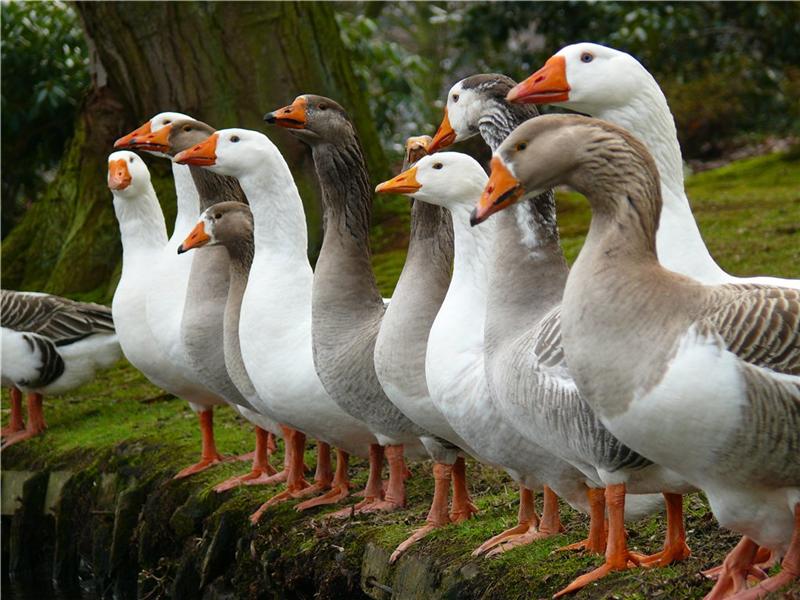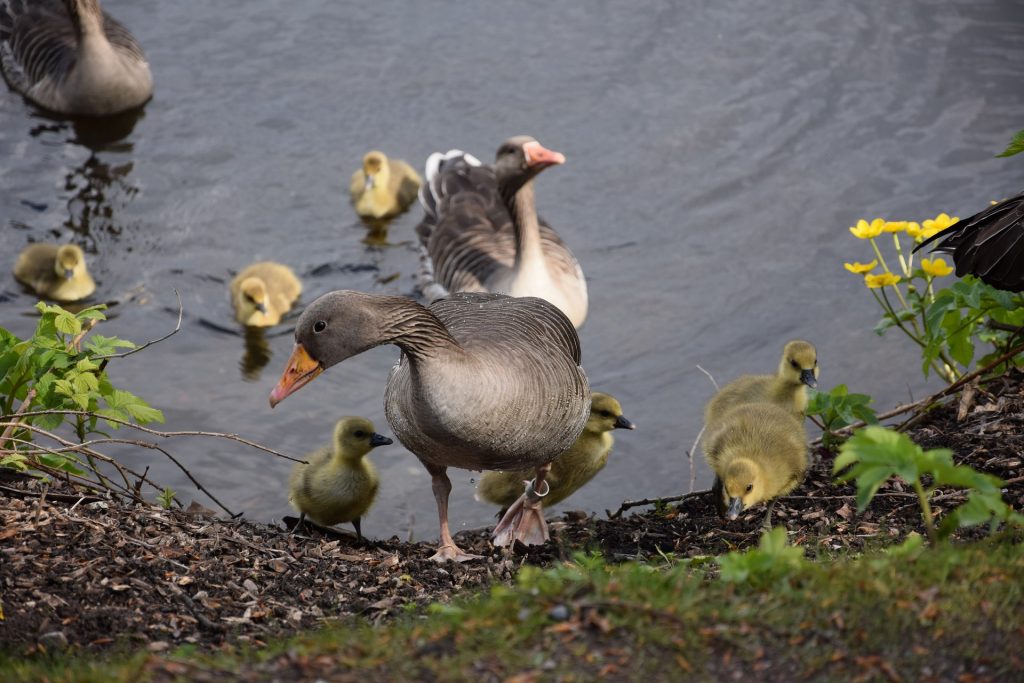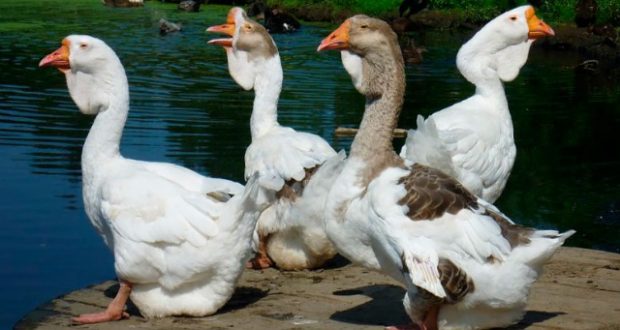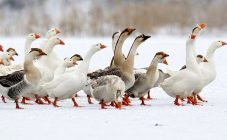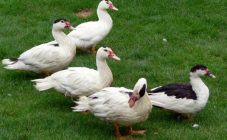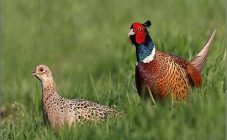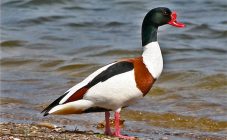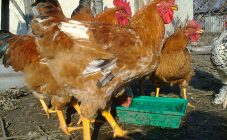Content:
Humanity has tamed the descendants of gray geese, making them larger than their relatives, but depriving them of the ability to fly. Since antiquity, these birds have been bred for their meat, feathers and eggs.
Description of poultry
Today, the body length of an adult poultry ranges from 70-80 cm, and the weight can reach 10 kg. Outwardly, the goose resembles a swan, only it cannot boast the same long, curved neck. Geese are waterfowl, so there are membranes on their paws between the toes, which help them to swim. The goose beak is usually taller than it is long. In the Chinese goose, the so-called frontal tubercle is located above the beak - a cone-shaped growth. A special autosomal gene is responsible for it, as well as for the appearance of a "wallet" (folds under the beak).
It will be difficult for an unfamiliar person to distinguish between a female and a male by external signs, usually this is done by an almost imperceptible difference in the shape of the beak. In addition, the male behaves a little more aggressively, can scream, and all because under his protection are children-goslings.
Unlike its counterparts, the domesticated goose does not usually fly. The owners usually clip their wings for fear of losing a whole flock.
Do geese fly at all? Wild birds leave their homes in winter to wait out the cold in the south, and return in spring.
Even in antiquity, geese were often bred as fighting birds, and this was even more popular than cock fights. They could attack each other, roll over, hiss loudly. Many people always gathered to see them, and a good trained fighting goose was the pride of the owner and almost a tourist attraction.
Growth process
In good conditions, the life of domestic geese lasts 18-20 years. How long do wild geese live? The indicator practically does not differ, their life expectancy is also about 20 years.
Small goose does not stay long. In less than a year, it can be slaughtered in the fall. How many geese grow, so much they live almost like in paradise: they eat abundantly on the best food and stay warm, but as soon as the first frosts begin, as birds weighing 3-4 kg, as a rule, go to soup.
Growing these birds requires knowledge of many nuances.
Favorable conditions the gosling needs
If the young have to be raised without a mother, a person literally replaces her
Chicks need eye and eye and round-the-clock care, which means they will have to get up early. The room in which they are to live should be light, and most importantly, warm and dry. The goose, incubating its children, maintains a temperature of 27-29 ° C, the same should be in their enclosure. A special infrared lamp will help a lot with this.
On the first day, immediately after hatching, the goslings should be fed with boiled eggs. In the following days, you can gradually switch to compound feed. When 1 week has passed, vitamins (fish oil), bone meal and cottage cheese will be added to the diet. After 10 days, you can already give the chicks finely chopped greens: young nettles, dandelions and even green onions. Having strengthened, babies can switch to solid food: cereals and cereals.
But giving them beets is not worth it - they can store them, and then the breeder will not turn into problems. Small chicks that are not yet resistant to disease can get smeared with waste, get sick, and God forbid they infect the entire brood, treatment will be required. If the goslings do not get enough vitamins, the livestock can also get sick, or even begin to die. They need plenty of water to drink, as well as a shallow pool (a basin filled with warm water is fine) so that they can practice swimming and grow feathers.
When the mother incubates the chicks, on the one hand, everything is simplified, on the other, difficulties inevitably appear.
You can release the brood into an open space for 3-4 weeks. The goose will lead them to the lake, where they can live all summer without requiring additional feeding.
In order for a flock to be guaranteed to return home, you need to know how geese are called. Everything works in the same way as with pet names. Each time, pouring food to the chicks, they repeat some convenient phrase, for example, "Geese-geese-geese" or "Ha-ha-ha." The first option is preferable, because whistling sounds are more easily perceived by both small chicks and grown-up birds. And it is much more convenient to call birds by their familiar name.
A month-old gosling gets summer plumage, and later - soft autumn plumage. At the age of 3 months, goslings develop wings, and after six months they become fully formed young geese. Therefore, the selection is made in the fall, usually at this moment the goose loses interest in its already adult children, and they can be painlessly divided.
What goslings should be left for further breeding? The healthiest chicks, in which the characteristics of the breed, strong and large, are clearly visible, survive, and in the future their main function is to produce offspring. When selecting, pay attention to their legs, beaks and feathers. Nothing should look unhealthy or underdeveloped.
What breeds are best for home keeping
If every village can boast of chickens, then geese are born less often and mainly for the sake of meat, because even the most prolific geese do not rush so often. Cooking poultry meat in an iron oven will make the dish appetizing for anyone, but for this you need not only to know how to make marinades, but also to choose the right breed.
- Large gray geese. The gray goose is a very prolific bird. This particular breed is famous for being perfect both for producing purebred offspring and for crossing. Their difference is that they do not need a reservoir.
- Lindovsky geese. In addition to delicious meat, they also have soft fluff. Due to this, they quickly adapt to any climatic conditions. Even novice farmers will easily succeed in breeding this breed.
- Toulouse geese. To all the other advantages of this breed is added the fact that it is from their liver that a delicious pate, known throughout the world as foie gras, is made.A few days before the New Year holidays, their meat is bought from store shelves.
- Chinese geese. This breed is famous for the fact that geese can lay up to 100 eggs per season. But their body weight usually does not exceed 5 kg, so breeding them for slaughter does not make sense, despite no less tasty meat than other breeds.
- Kholmogory breed. The advantage of these birds is that they gain weight very quickly - 5 kg in a few months. And adult males can weigh over 12 kg. Most importantly, they are very resistant to typical avian diseases, so they do not need to be treated often.
Diseases and their prevention
It doesn't matter if birds are bred for meat or to continue the breed, their diseases always have an unpleasant effect on the owners, causing concern for the birds. The conditions of their detention strongly affect the immunity. Little goslings are especially finicky in this regard.
- Low temperature and draft can be very harmful to chicks, causing colds and viral diseases, inflammation.
- Dirty stagnant water in the drinker, dampness, and insufficient feeding can also cause serious illness.
The dishes must be cleaned and rinsed in a timely manner so as not to cause intestinal diseases in geese. By just getting on the skin, droppings can be carried anywhere, including the drinker, so it is important to give the birds plenty of room and change the bedding.
When geese begin to shed, they should be fed with a vitamin complex, as the body is rebuilding, experiencing stress and needs support. You need to release the livestock into the garden every day. The sun's rays and fresh air affect them as well as people.
Breeders of geese of various breeds can face the following diseases:
- If the goose refuses food, is slow and apathetic, begins to fall from weakness, cannot get up, most likely, he suffers from vitamin deficiency. The solution may be to change the feed to a new one and add fresh herbs and fish oil to it.
- If birds sit day and night in a confined space, it is not surprising that they have rickets. Its characteristic symptoms are a softening of the beak, general weakness of the body and a thin shell of eggs in geese. The disease occurs due to a lack of vitamin D and sunlight. The best treatment is the addition of an appropriate vitamin and day walks.
- Diarrhea. Tousled feathers, growth retardation and even paralysis indicate intestinal upset that can lead to serious consequences. In this case, the geese need to add vitamin B, bran and as much greens as possible to their food.
- Inflammation of the mucous membrane of the cloaca (cloacitis). Like many others, this disease is caused by a lack of vitamins: A, D, E. In infected birds, the mucous membrane of the cloaca protrudes, cracks and sores can be visible on it. In this case, preventive measures cannot be dispensed with - you need to resort to antibiotics. Streptomycin and penicillin ointments are applied to the cloaca membrane. Before that, you need to cleanse it of pus by smearing it with iodine solution and zinc ointment.
- The scary word often confuses farmers, but cannibalism is officially one of the most common diseases among geese. What are the reasons for such cruelty among birds? If they are kept in close quarters, and there is not enough protein in the body, geese begin to peck at the bodies of their relatives with their beaks. The presence of a wounded goose in the poultry house provokes others to aggression towards it, therefore, with the appearance of one, it is necessary to separate it from the rest, and then give the birds sufficient food and a place to live.
- Goiter catarrh is more common among aging geese. The goiter is swollen, and the geese walk a little, they can sit down, ruffled. The goiter should be massaged, and a 5% hydrochloric acid solution should be added to the drinking water. If necessary, give drinks by force.
We must not forget that many avian diseases are contagious and pose a greater danger to humans than to a goose.Therefore, care must be taken when caring for a sick pet. Hand or sleeve touching infected areas should be carefully handled. Even the droppings of a sick bird on clothes can cause a lot of trouble. The main condition is compliance with such simple measures as the use of disposable gloves and hand washing.
Thus, breeding geese is not at all difficult, especially for those who have experience in keeping chickens or ducks. Even an inexperienced farmer can do everything, the main thing is to pay attention to the nuances described above.
